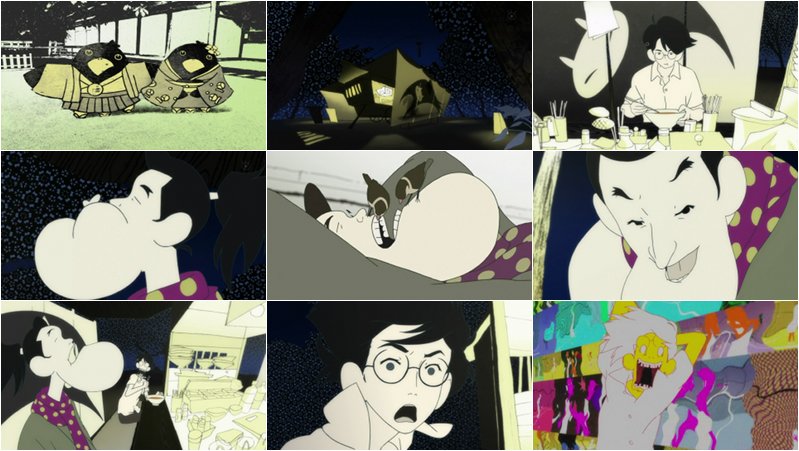
Boy has overly romantic view of college life. College life fails to live up to his fantasies and he becomes the enemy of romance, via the “help” of a trouble causing friend. Possible divine intervention occurs.
Let’s get the major issue with The Tatami Galaxy out the way first. It is very wordy. I think the wordiness itself is more of an issue than the rate at which the words are delivered (very fast).
I’m not sure if this wordiness is born from it being an adaptation of a novel, or if it’s a specific creative choice. I’d guess the former, simply because Masaaki Yuasa’s other works aren’t wordy in this way and novel adaptations in anime (and elsewhere) find themselves driven by internal monologue in the same way this episode was. Not having access to the original text though means that’s all guesswork on my part, so take it with a pinch of salt. Another difference between this and previous Yuasa projects is the involvement of playwright Makoto Ueda (Summer Time Machine Blues, Go Find a Psychic!), so that may also have influenced the verbosity of the production.
So, having established that monologues are often par for the course for these sorts of adaptation, how does The Tatami Galaxy deal with it? By going about three times as fast as anyone else would go.
That works well in terms of giving the episode a rhythm to work to, but it presents challenges in watching subtitled animation that don’t necessarily exist with conversational dialogue at the same speed. The rhythm of back and forth dialogue lends itself better to rhythms of reading and watching animation than more complex monologues do. If you want a comparison with an English language cartoon, try to imagine watching Tex Avery’s Symphony in Slang with subtitles. Even then, the narration seems positively sedate compared to The Tatami Galaxy‘s. I wonder if the between narration beats that Avery leaves are also present in Tatami Galaxy, but lost when you have to read as well.
I thought I had coped perfectly well, and never felt I was struggling, but going back and watching again without subtitles, I discovered images and details in the animation I’d completely overlooked. That’s fine however, as it’s a joy to watch again and again (though I didn’t go quite as mad with it as I did Kemonozume‘s opening episode which I’d watched three times before I even had subtitles to go with it).
So don’t let the machine gun monologues put you off, as ultimately it is a very minor quibble for what is likely to be one of the best TV shows of the 21st Century.
Visually it’s a treat. It’s full of fantastic shots, movement and character design. Despite it looking different, once again, from Yuasa and Nobutaka Ito’s previous collaborations, you can still tell it is their vision that is driving the overall look of the show. That has a lot to do with the fact that not many creators working in anime would have created a cast of such diverse body shapes and facial features, something they also did in both Kemonozume and Kaiba.
In this episode you’ve got the relatively normal looking lead and the object of his affection, Akashi (though she too is not above cartoon warping of her form), and on the opposite side of the design spectrum, the devilish looking Akashi and a god of matchmaking who’d give Popeye a chinferiority complex.
Ozu is clearly the character that people are going to have most fun animating, and his voice actor Hiroyuki Yoshino (Kazuma Momota in Kemonozume) seems to be relishing the scenery chewing the role gives him. It’s great to have cartoon characters who act like they are. And the final scene he’s involved in this episode leaves so many questions unanswered that you’ve got see more.
If you are in the US you can watch this via Funimation’s various portals, which is great news for Americans who like awesome animation. The rest of us outside of American or Japan will have to use the Evil Powers of the Internet to get to it. It’s worth it either way, as it is just a joy to see something both this idiosyncratic and this well made.